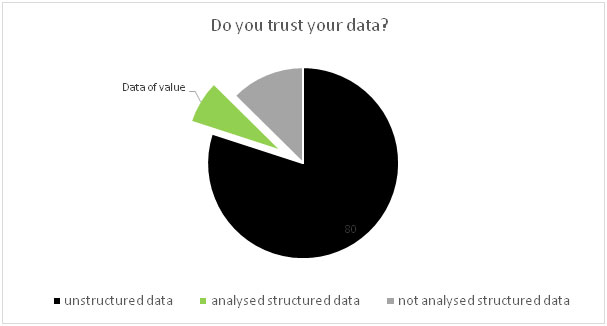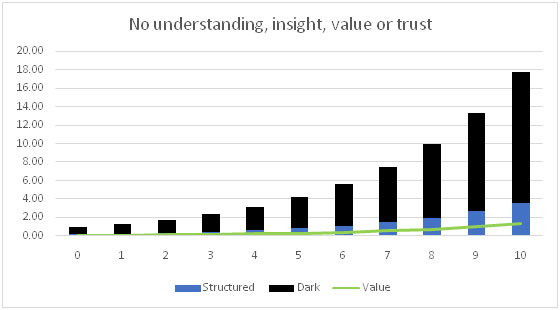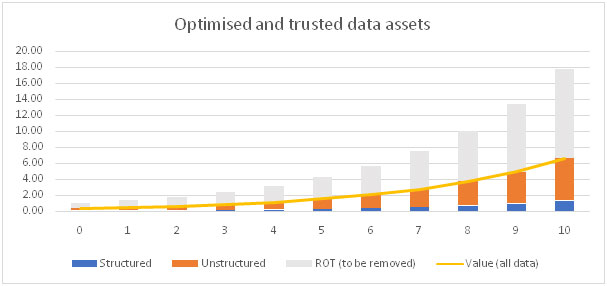“Trusted Data”, regardless of the level of trust, is data you can rely on to process information from. Its information used to gain knowledge, make decisions and act upon. Bloomberg LP say, “Because data affects the entire enterprise, solutions that deliver trusted, reliable data have similarly wide-reaching benefits. Firms that figure out how to improve data quality will be better able to deploy new strategies, reduce costs and improve performance.”

To determine whether or not you trust your data, consider your answers to these questions…
- Do you understand the data protection risk inherent in your data?
- Can you make informed decisions on the data you’re supplied?
- Are you efficiently curating data ready for analysis, automation or artificial intelligence?
- Are you getting value from the data you store?
- Is your data fit for purpose?
If you answered “no” to any of these questions or you’re not sure of the answer, then it’s likely that you have a level of mistrust in your data. However, don’t worry, you’re not alone…
A growing number of business executives are expressing the view that they don’t trust their data. Furthermore, they are saying that they are not maximising the value and potential of their data assets, and they are becoming increasingly worried about their data protection and compliance risks. One commentator recently suggested that 94% of business executives expressed the view that their organisation has suffered because of data errors. Worryingly, this figure is up from 92% the year before!
A recent poll asked whether people viewed their organisation’s data as an asset or a liability? Overwhelmingly, the view expressed was that their data was an asset. However, it seems that the answer provided depended a lot on the role the person responding had within the organisation. The worrying undertone is that the closer you are to working with the raw data, the less likely you are to view your data as an asset, the less likely you are to trust the data.
By way of example, its well reported that data analysts, data engineers and data scientists spend over 50% of their time munging and cleansing data to make it fit for purpose. They don’t see data as an asset.
Data protection officers (DPOs) see the huge amounts of unstructured data being stored with little or no effective control policies in place for minimisation, retention and consent. They see the organisation’s data as a huge data protection risk. Rightly so, as 78% of organisations reported by IT Pro Portal claim to have little or no understanding of what is happening with their unstructured data. In short, not many DPOs see data as an asset.
IT are often the go to team to provision data, with 46% of organisations according to Bloomberg leaning on that business unit to address their data issues. Despite their best efforts they know it’s not managed or governed, is a risk and of poor quality, but they don’t have the resources, controlor perhaps even the domain knowledge to sort it out.
Business executives making decisions on poor quality information, lack trust in data and certainly don’t view the data as an asset.
Summary
Summarily, despite the trumpeting of data as the new oil, air, gold, i.e. the business’ most important asset etc… there is clearly a lot to do within the data processing and management camp within the organisation to change the perceptions held by the folks working most closely with the data.
Fortunately, there are things that you can do to change the effectiveness of your data management strategy and its execution. Ways to save money, reduce risk, increase insight and rebuild trust in your data.
Read on to discover more….
Is the case for data mistrust justified?
Research by IDC predicts that by 2025 over 80% of data stored within the enterprise will be unstructured. This is free text, documents, images, video, transactional data from streamed IoT, emails, contracts, social media etc. Held in unstructured data stores like Shared Drives, cloud stores such as SharePoint, OneDrive, Azure, AWS, Google Drive, Dropbox etc. and to a lesser extent document management systems.
As IT Pro Portal have suggested, 78% of organisations have little or no understanding of their unstructured data. One reason why is that they have little or no insight into the meta data (the data describing what the data is). They cannot search it, cannot analyse it and therefore have little to no understanding as to what it is or whether it is a cost, risk or of value! It can’t be trusted.
As 80% of data is of the unstructured variety, this means that structured data (that stored within databases and other structured data formats), is just 20% of the whole data estate. But…
IDC go on to suggest that just 37% of data that we can and do analyse has value to the organisation. So we get value from just 37% x 20% (of the whole data estate) = 7.4% as shown in the following illustration.
 As we can see, organisations have very little insight into the data they are storing (I prefer the term “hoarding”) and as a result are getting very little or no value from it. Furthermore, they are incurring significant costs of storing it and running a huge (and growing)data protection risk as well. In short, they don’t trust it and are becoming increasingly concerned about it.
As we can see, organisations have very little insight into the data they are storing (I prefer the term “hoarding”) and as a result are getting very little or no value from it. Furthermore, they are incurring significant costs of storing it and running a huge (and growing)data protection risk as well. In short, they don’t trust it and are becoming increasingly concerned about it.
To compound the problem, the situation is about to get much, much worse. IDC have predicted a ten-fold growth in data from 2016 through 2025. From observations with our customers, we’re seeing data estates doubling in size every 2 to 3 years and accelerating! So, if we consider that your data estate, say, doubles in size every 3 years, then you’re looking at an 18x multiplier in storage cost and risk in 10 years’ time. The illustration below shows just what little value you are likely to be getting today and will continue to get from the data you store.
When there is so little insight or transparency into the data you store, it’s described as being dark, trust is a casualty.
 What can you do to increase trust in your data?
What can you do to increase trust in your data?
The key to unlocking value and increasing trust in data is in the organisation’s capacity to provide the means of accessing, understanding and analysing all its data.
You can use a tool like infoboss to curate views of your data for your data consumers to leverage value from your data assets be they structured or unstructured. Turn your data engineers into data alchemists transforming your raw data into the acclaimed data gold.
For unstructured data sources this affords opportunity to reduce the size of the data estate (cost and protection risk surface area) by as much as 60%. Did you know that 58% of data stored is redundant, obsolete, trivial or duplicated (ROT)?A massive opportunity to get some quick wins and remove it, but you have to be able to find it first and this is where a curated view of the meta data within your unstructured data assets is of great value.If you don’t believe me, ask your data protection officer as to how valuable this could be!
You could also increase the quality of your data, and in so doing, analyse it and leverage more value from it. You can use infoboss to improve the quality of your data by embedding sustainable data quality management processes, massively reducing the demand on your front-line data workers and empowering data owners to take control of the processes for improving the quality of the data you store.
The opportunity and goal of every organisation’s data strategy should be to increase the value from data closer to 100% of the data stored rather than the 7.4% being seen today. By managing removal of ROT, adding meta data and structure to your unstructured data and improving data quality you are laying the foundations for rebuilding trust in your data.
You will be shining a light on data assets making them easier to manage, search, analyse and understand. By removing ROT you’ll be reducing storage costs by over 60% and greatly reducing your data protection risk surface area.
By managing the quality and integrity of your data, you increase the volume of data you can analyse, reducing the cost of errors and inefficiency associated with poor quality data, and of course increase the trust you have in your data.
An optimised data management approach with infoboss affords the opportunity of insight from all of your data which in turn increases value and trust in it.
 If you’d like to increase trust in your data and in so doing, maximise the value you’re getting from it, then infoboss and our partners are here to help.
If you’d like to increase trust in your data and in so doing, maximise the value you’re getting from it, then infoboss and our partners are here to help.













